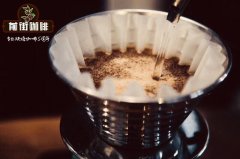There are several waves of coffee to understand that the next fourth wave of coffee has a complete traceability.

Professional coffee knowledge exchange more coffee bean information please follow the coffee workshop (Wechat official account cafe_style)
Qianjie-brief introduction of Coffee Tide
In the industrial revolution and the two world wars, coffee and tea played a refreshing and invigorating role. Instant coffee was the product of this period, emphasizing convenience, speed and cheapness, and the period when human beings began to drink a lot of coffee was called the first wave of coffee process.
Although instant coffee is efficient and cheap, its taste is really unflattering. With the stability of the world situation and the improvement of people's living standards, the coffee shop chain led by Starbucks has become a new favourite, which is the second wave of coffee process, marketing and packaging into an attitude towards life.
When more and more people drink coffee, and the origin information is becoming more and more transparent, there is naturally a group of coffee-loving gluttons, practitioners and customers, constantly looking for real top coffee because of love. Sacrifice time efficiency and profit in order to get a good coffee with excellent flavor, this is the boutique coffee that people often talk about, that is, the third wave of coffee process.
The fourth wave of coffee, in fact, is to understand the upstream story of coffee fruit crops-not only pay attention to the origin, but also have a better understanding of which estate the coffee beans come from. The names of coffee are listed in detail like red wine from producing countries, estates, coffee varieties, grades, as well as the treatment methods and years, batches and so on.
Over the past two years, more and more "manor roasting coffee shops" have opened in China, Japan and South Korea with an emphasis on self-baking from the origin. The so-called manor coffee refers to the direct delivery of coffee beans from the coffee producing area to the boutique coffee shop. These coffee beans will reflect the local local characteristics to a certain extent, and the products of each manor will have their own characteristics because of the microclimate and different production techniques, so they retain the most primitive and excellent flavor of coffee beans.
You can generally know the flavor of the wine from the label on the wine bottle, and the name of the manor coffee bean is the same. The bag lists the country of production, then the region, and then shrinks to a single manor or cooperative. Finally, there is the variety and grading of coffee grown in the manor or cooperative, as well as the treatment, vintage, batch, and so on. For example, African Kenyan garden beans, their packaging description is: Kenya (Kenya), Ruiru (origin), Tatu Estate (manor) 16-17 (vintage) Bourbon (beans), etc., compared with the general consumers on the market can access more detailed information, so that drinking coffee, become as delicate as wine tasting.
One of the most famous estates in the coffee industry in recent years is the Emerald Manor (Hacienda La Esmeralda) in Panama. The rosy summer coffee beans produced by the estate were successfully auctioned for $601 per pound at the 2017 auction of the Best Panamanian Coffee, making it one of the most expensive coffee beans in the world.
In addition to the Emerald Manor, there are Pacamara coffee beans (Pacamara) from Incht Manor in Guatemala, musicians' series coffee beans from Carnett Manor in Costa Rica in Central America, hot in Asia, Yega Sheffield coffee beans from Ethiopia, etc.
Knowledge: "Arabica" is not synonymous with good coffee, even if it is Arabica, there are hierarchical differences.
In short: Qianjie is a coffee research hall, happy to share the knowledge about coffee with you, we share unreservedly just to make more friends fall in love with coffee, and there will be three low-discount coffee activities every month. The reason is that Qianjie wants to make more friends drink the best coffee at the lowest price, which has been Qianjie's tenet for 6 years!
END
Important Notice :
前街咖啡 FrontStreet Coffee has moved to new addredd:
FrontStreet Coffee Address: 315,Donghua East Road,GuangZhou
Tel:020 38364473
- Prev

Robusta Coffee Bean Variety Features What Robusta Coffee Bean Tastes Hard to Eat
Professional coffee knowledge exchange More coffee bean information Please pay attention to coffee workshop (Weixin Official Accounts cafe_style) Front Street-Robusta coffee bean introduction Robusta coffee is generally planted in tropical areas and at low altitude, easier to plant and more resistant to pests and diseases
- Next

What are the differences in the taste of different coffees? coffee beans compete with each other in taste.
Professional coffee knowledge exchange more coffee bean information please follow the coffee workshop (Wechat official account cafe_style) front street-three major varieties of coffee introduction Arabica (Arabica) Arabica raw beans appearance should be small, a little oval, and the back is more smooth and complete, the main producing areas Ethiopia, Nicaragua, Costa Rica, Brazil, Central and South America and other countries
Related
- Beginners will see the "Coffee pull flower" guide!
- What is the difference between ice blog purified milk and ordinary milk coffee?
- Why is the Philippines the largest producer of crops in Liberia?
- For coffee extraction, should the fine powder be retained?
- How does extracted espresso fill pressed powder? How much strength does it take to press the powder?
- How to make jasmine cold extract coffee? Is the jasmine + latte good?
- Will this little toy really make the coffee taste better? How does Lily Drip affect coffee extraction?
- Will the action of slapping the filter cup also affect coffee extraction?
- What's the difference between powder-to-water ratio and powder-to-liquid ratio?
- What is the Ethiopian local species? What does it have to do with Heirloom native species?

